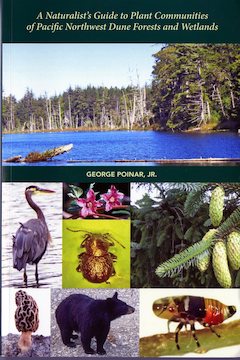A Naturalist’s Guide to the Hidden World of Pacific Northwest Dunes
Last Updated on November 21, 2022 by

by George Poinar, Jr.
ISBN 978-0870718540
Oregon State University Press, Corvallis, Oregon, 2016
This book is a great addition to a bookshelf of coastal field guides because, plant by plant, it describes herbivorous insects that live on common coastal plants, and their insect predators and parasites. The herbivores also include a few mammals. Growing up on the beach, I pored over kelp tangles and driftwood, and wondered what the bugs were that hopped off, flew away or burrowed for cover. Fifty years later, here’s the book to help name those bugs.
George Poinar, Jr., received his PhD at Cornell, with an emphasis on entomology, botany, plant pathology and vertebrate zoology. He taught at University of California, Riverside and Berkeley, and was adjunct faculty at Oregon State University. He popularized the concept of extracting insect DNA from amber, which was adapted by Michael Crichton for his Jurassic Park books and movies. He has written several books about amber, fossil insects, and fossil insect communities, including Lebanese Amber (2001). Sea coast insect communities on plants are a lifelong interest.
The book is organized by plant communities, starting with kelp tangles and driftwood on the tidal beach, progressing up the beach to open sand plant species, and to dunes. Sixty plants are featured, counting kelp tangles and driftwood each as a “plant community.” Plants are grouped loosely by abundance within each community, with most abundant species featured first. In the dune section, the most abundant are marram grass (Ammophila arenaria) and American dune grass (Leymus mollis) and the least abundant is springbank clover (Trifolium wormskjoldii). The author illustrated the descriptions of each plant and its community of insects with outstanding photos. These photos elevate this book from an interesting read to an indispensible field guide. In addition, he has compiled a reference table for each plant’s community of insects, including herbivores, predators, and parasites. A glossary in the back covers both botanical and entomological terms. Plant nomenclature is based on the Jepson Manual.
Some plants have complex food webs of insects living on and around them, while others are associated with only aphids and a fly or two. Such is the contrast of insects associated with shore pine (Pinus contorts contorta) or coast willow (Salix hookeriana) to those of beach silver top (Glehnia littoralis). Poinar considers the first two to be keystone species, which harbor insect communities composed of more than a dozen species and include herbivores, predators and parasites.
One of the most striking photos portrays an orchid pollinium on the leg of a mosquito in the section on bog rein orchid (Platanthera leucostachys) on page 234. There has been considerable discussion recently about the role of (annoying, biting, disease-carrying) mosquitoes in the ecosystem. I was pleased to see proof that these small nectar-sipping insects function as pollinators.
There are a few errors. Despite the title, the scope includes a number of plants that grow only in California, including beach layia (Layia carnosa), and Indian paintbrush, (Castilleja exserta). The diverse dune community of rushes is condensed into one species labeled “Dune Rush, Juncus effusus.” The rushes shown in photos include Juncus falcatus and J. lesueurii. The list of insects on springbank clover includes a “Flower butterfly” (Plebejus saepiolus), which is more commonly called Greenish Blue Butterfly. In the section on coastal sagewort (Artemisia pycnocephala), the range for California ground squirrel (Spermophilus beecheyi) includes Washington. North of the Columbia River, this squirrel is not coastal; it lives in the Gorge. Deer, mentioned many times as grazing on various plants, are identified as white-tailed deer (Odocoileus virginianus); this species does not come close to the coast except along the Columbia River. Black-tailed deer (Odocoileus hemionus columbianus) is common on beaches throughout the Pacific Northwest, and the photo shows black-tailed deer.
But these are trivial errors. The strength of the book is in its photos and descriptions of insects that live on common plants of dunes, beaches, and drift. I recommend it to anyone who wants to learn the bugs on seaside plants, or anyone who has curious children or grandchildren with whom they can share the wonders of nature.
—Kathleen Sayce, Filipendula Chapter.
